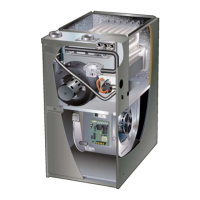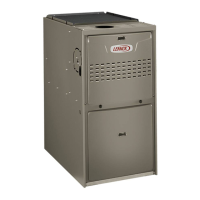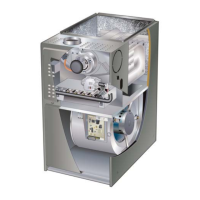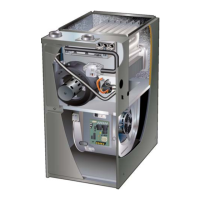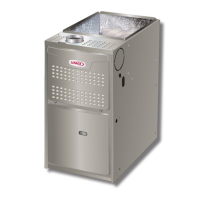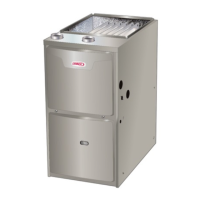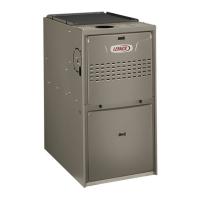Page 49
Repair Parts List
The following repair parts are available through Lennox
dealers. When ordering parts, include the complete fur-
nace model number listed on the CSA nameplate -- Ex-
ample: ML196UH045XE36B-01. All service must be
performed by a licensed professional installer (or
equivalent), service agency, or gas supplier.
Cabinet Parts
Outer access panel
Blower access panel
Top Cap
Control Panel Parts
Transformer
Integrated control board
Door interlock switch
Blower Parts
Blower wheel
Motor
Motor mounting frame
Blower housing cuto plate
Heating Parts
Flame Sensor
Heat exchanger assembly
Gas manifold
Combustion air inducer
Gas valve
Main burner cluster
Main burner orices
Pressure switch
Ignitor
Primary limit control
Flame rollout switches
THE PROVINCE OF ONTARIO, HORIZONTAL SIDEWALL VENT APPLICATIONS ONLY
For exterior horizontal venting applications, the 2” X 1.5” reducer for 2” venting at the point where the exhaust pipe exits
the structure is not required in direct or nondirect vent applications in the Province of Ontario. In these applications, the
vent should be oriented such that the exhaust plume is unobjectionable. If the installation requires more separation be-
tween the ue gases and the building structure, a reducer may be installed on the exhaust pipe to increase the ue gas
velocity.
ADDENDUM FOR ALL THE PROVINCES OF CANADA
See below for venting in all the provinces of Canada. Lennox approves the following termination for use in all the provinces
of Canada.
C
12”
D
B
A
2” (51MM)
Vent Pipe
3” (76MM)
Vent Pipe
12” (305 mm) Min. 12” (305 mm) Min.
6” (152 mm) Min.
24” (610 mm) Max.
6” (152 mm) Max.
6” (152 mm) Min.
24” (610 mm) Max.
6” (152 mm) Max.
A − Clearance above grade or
average snow accumulation
B − Horizontal separation between
intake and exhaust
C − Exhaust pipe length
D − Wall support distance from top
of each pipe (intake/exhaust)
NOTE − Flue gas may be acidic and may adversely affect some building materials. If flue gases impinge
on the building materials, a corrosion−resistant shield should be used to protect the wall surface. The
shield should be constructed using wood, sheet metal or other suitable material. All seams, joints, cracks,
etc. in affected area, should be sealed using an appropriate sealant.
Per: Saskatchewan Code of Practice
